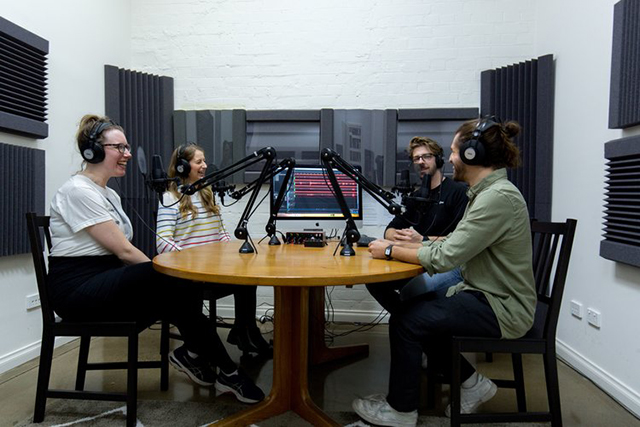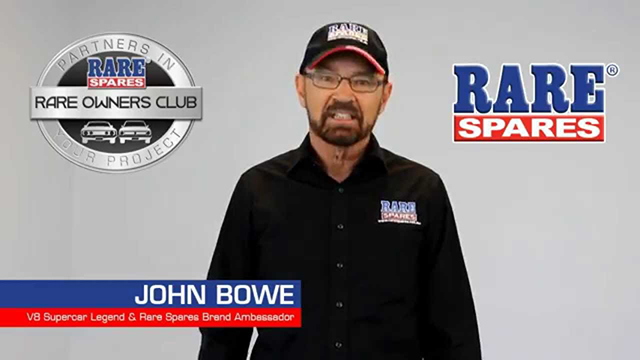It’s been said that anyone can be a journalist nowadays. This is due to the preponderance of smart devices and social media. Major news corporations actively request input from their viewers and readers to help supplement their own generated content. In a way, though, this is a bit “hit and miss”, somewhat scattergun in approach and reception.

What about a targeted approach, a channel, as such, to provide content for a specific audience? YouTube is well known for offering just that, and yes that could even mean videos of sleeping cats. But it’s also now, as is podcasting, a viable and genuine media outlet, especially with areas of interest such as automotive. We spoke to our Rare Spares ambassador, John Bowe, and respected broadcaster and 2.3 million downloads of his podcast episodes “Rusty’s Garage” host, Greg Rust to get some thoughts on why and how these avenues are more than what meets the eye (and ear).
Rusty.
their advice. 
With a media and motorsports career that goes back to the early 1990s, there really are few more qualified people to speak to about automotive related content for home use than Greg Rust. He’s worked for major media groups and motorsports organisations, plus has his own racing and rally driver experience. This near thirty years of door opening has provided him with an extensive list of contacts, and crucially, an extensive exposure to what he now does in cyberspace.
In 2017 Rusty decided to make a change in direction, and spoke to some people “in the know” about providing online content.
This content, he decided, would be in the form of a podcast. The name “Rusty’s Garage” was quickly settled upon, but that’s where the easy bit stopped. Here’s where his experience in the media for laying out how a podcast comes into play.
One of his first interviews was with Australian rally driver, Molly Taylor. A talented steerer and media savvy person in her own right, Rusty spent well over two hours talking with her about her career. An important part of compiling a podcast, says Rusty, came from this. Make it conversational.
Rusty lists the great interviewer Sir Michael Parkinson as a hero and an influence on his work, and says that a conversational style, very much like “Parkie’s” makes for a more listenable experience. This then lead into how a podcast can be more accessible than the more traditional forms of media, in that it can be listened to “live” as an almost radio broadcast style via streaming, or it can be downloaded, stored, and played at any time, and anywhere.
Rusty says he’s had contact from people that have been working on cars, or enjoying the company of like minded people, as they’ve listened to a downloaded show and played back in a social environment.
Another crucial point, says Rusty, is creating a show that is part of what you do. What he infers here is that someone that has little to no knowledge of, say, aftermarket automotive parts, would more than likely fail at creating a listener friendly program. Again, though, his experience brings forth a possibly surprising link.
Find a point of difference, he suggests, and certainly research podcast providers to see if a show you have in mind is represented, and then, in which kind of numbers. The example discussed was hydroponic tomatoes. Out of that came the link to Australia’s fastest tomato farmer, Victor Bray, one of Australia’s best known drag racers. His background involved tomato farming.
Hydroponics, he says, as a show, could be already very well represented, and therefore a new podcast could be lost “in the noise”, however if a show has something a little out of the ordinary then there’s a better chance of “cut through” to snare a new audience. This points out that a theme for a show is important. Lay down a development path, not an ad hoc “let’s see how it goes”.
Rusty acknowledges that his (and there’s a wince in his voice) “profile” has helped when it comes to the success of his show, but he also says this shouldn’t be a necessity for anyone looking to create a show. He expands upon this by using an example of a person that may be a presenter on a particular tv show, and their role is to be the visual point of contact for a product.
Here it becomes a point of difference; that difference being that an audience’s perception of those is unlike those of someone that is known to have exposure and relatability to a product and is seen by an audience as trustworthy BECAUSE of their relationship to a product. He’s at pains to explain that it doesn’t mean a person has to be a product ambassador or a paid sponsor. It’s more, if you will, the believability factor of what’s being spoken and therefore how it’s received by a listener or viewer.
A great example of this is “Project Monaro”. In an automotive and motorsport sense someone like Craig Lowndes can be related to by an audience because of his experience and his perceived relationship with the product, in this case project Monaro’s rebuild and restoration story.
This circles back to his point about presenting a program about something you, as a presenter, would be able to “sell” to a listener because of the relationship with the topic.
His final point was about the story that can be told. Again this embraces the relatability of the topic, and the conversational side of how the show can be presented. With much of his own media experience comprising interviews with drivers in motorsport, or team owners and the like, this advice comes as no surprise. Find the part of what someone has that could be something that a listener will engage in.
YouTube
John Bowe is the public face of Rare Spares. As the company’s ambassador, JB travels the country and represents the broad spectrum of what Rare Spares offers. One of the most easily accessible ways John gets the Rare Spares message out is via video, either on social media or YouTube.

When it comes to content provision, John agrees that a knowledge of your subject is critical. It comes as no surprise that John is able to easily present on camera when it comes to automotive subjects thanks to his four plus decades of motoring and motor sport work.
JB says he listens to a number of podcasts himself, and not unsurprisingly they’re mainly motor racing in content. This brought John to advise that research, much the same as Rusty says, into your chosen subject matter, will pay bigger dividends in how your videos are perceived. Bring a sense of knowledge, of confidence, and enthusiasm, and the audience will be able to relate more to the content.
John, like many, has the innate ability to present to camera with an unrehearsed, off the cuff style. This lends itself to a free flowing, conversational, narrative. However, says John, if you’re a person that uses scripts, keep them uncluttered of jargon, relatively short in sentence structure, and timed to generally no more than five minutes. This is because, he says, research and feedback to and from YouTube has shown that viewers average no more than five minutes of viewing time.
This takes us to the next step. John says that if there is something that needs a long viewing time, editing to break up into these five minute or so “episodes” can allow for both easier editing, and a more attention capturing presentation.
John is known for his entertaining and engaging style of presenting and interviewing. Here he recommends that a new person looking to provide YouTube content would need to consider how their presentation style works. John agrees with Rusty that interviewers such as Parkinson were so well received because of their own personality. Wit, humour, and occasionally being self deprecating win more viewers than a dry and monotone presentation.
When asked about the equipment used to record, John says a good smartphone is generally all that’s required. Good quality lapel microphones, a long cable or perhaps even a wireless receiver, a steady camera mounted location, and that’s it. Location is then important, as are background visuals. John recommends that if someone is going to visually present on, for example, spare parts for restoring cars, a few props such as the parts, or in a garage with a car, adds visual weight to the text being spoke.
Finally, says John. Be yourself, be the person that a viewer will relate to. This complements Rusty’s thoughts on being someone you can trust, rather than a talking head promoting a product.
Both men said that having a network, be it a business, or personal, or a combination, is important too, in reaching a chosen audience and expanding from there.
Both men have made their mark in their fields by being trustworthy, able to relate to from a viewer’s perspective, and because of their respective knowledge and experience. Rare Spares wishes to thank both Greg Rust and our ambassador, John Bowe, for their advice.